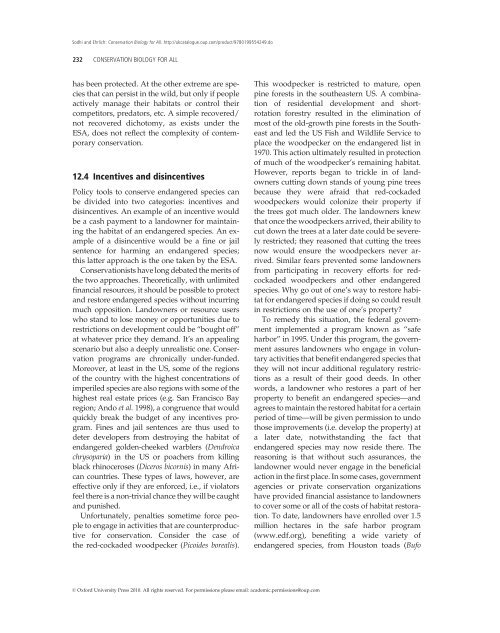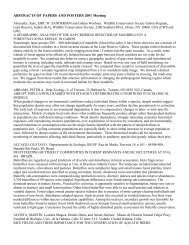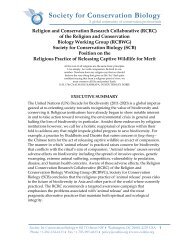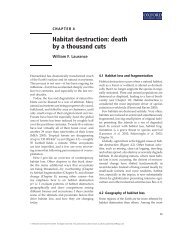Endangered species management: the US experience - Society for ...
Endangered species management: the US experience - Society for ...
Endangered species management: the US experience - Society for ...
You also want an ePaper? Increase the reach of your titles
YUMPU automatically turns print PDFs into web optimized ePapers that Google loves.
Sodhi and Ehrlich: Conservation Biology <strong>for</strong> All. http://ukcatalogue.oup.com/product/9780199554249.do<br />
232 CONSERVATION BIOLOGY FOR ALL<br />
has been protected. At <strong>the</strong> o<strong>the</strong>r extreme are <strong>species</strong><br />
that can persist in <strong>the</strong> wild, but only if people<br />
actively manage <strong>the</strong>ir habitats or control <strong>the</strong>ir<br />
competitors, predators, etc. A simple recovered/<br />
not recovered dichotomy, as exists under <strong>the</strong><br />
ESA, does not reflect <strong>the</strong> complexity of contemporary<br />
conservation.<br />
12.4 Incentives and disincentives<br />
Policy tools to conserve endangered <strong>species</strong> can<br />
be divided into two categories: incentives and<br />
disincentives. An example of an incentive would<br />
be a cash payment to a landowner <strong>for</strong> maintaining<br />
<strong>the</strong> habitat of an endangered <strong>species</strong>. An example<br />
of a disincentive would be a fine or jail<br />
sentence <strong>for</strong> harming an endangered <strong>species</strong>;<br />
this latter approach is <strong>the</strong> one taken by <strong>the</strong> ESA.<br />
Conservationists have long debated <strong>the</strong> merits of<br />
<strong>the</strong> two approaches. Theoretically, with unlimited<br />
financial resources, it should be possible to protect<br />
and restore endangered <strong>species</strong> without incurring<br />
much opposition. Landowners or resource users<br />
who stand to lose money or opportunities due to<br />
restrictions on development could be “bought off”<br />
at whatever price <strong>the</strong>y demand. It’s anappealing<br />
scenario but also a deeply unrealistic one. Conservation<br />
programs are chronically under-funded.<br />
Moreover, at least in <strong>the</strong> <strong>US</strong>, some of <strong>the</strong> regions<br />
of <strong>the</strong> country with <strong>the</strong> highest concentrations of<br />
imperiled <strong>species</strong> are also regions with some of <strong>the</strong><br />
highest real estate prices (e.g. San Francisco Bay<br />
region; Ando et al. 1998), a congruence that would<br />
quickly break <strong>the</strong> budget of any incentives program.<br />
Fines and jail sentences are thus used to<br />
deter developers from destroying <strong>the</strong> habitat of<br />
endangered golden-cheeked warblers (Dendroica<br />
chrysoparia) in <strong>the</strong> <strong>US</strong> or poachers from killing<br />
black rhinoceroses (Diceros bicornis) inmanyAfrican<br />
countries. These types of laws, however, are<br />
effective only if <strong>the</strong>y are en<strong>for</strong>ced, i.e., if violators<br />
feel <strong>the</strong>re is a non-trivial chance <strong>the</strong>y will be caught<br />
and punished.<br />
Un<strong>for</strong>tunately, penalties sometime <strong>for</strong>ce people<br />
to engage in activities that are counterproductive<br />
<strong>for</strong> conservation. Consider <strong>the</strong> case of<br />
<strong>the</strong> red-cockaded woodpecker (Picoides borealis).<br />
This woodpecker is restricted to mature, open<br />
pine <strong>for</strong>ests in <strong>the</strong> sou<strong>the</strong>astern <strong>US</strong>. A combination<br />
of residential development and shortrotation<br />
<strong>for</strong>estry resulted in <strong>the</strong> elimination of<br />
most of <strong>the</strong> old-growth pine <strong>for</strong>ests in <strong>the</strong> Sou<strong>the</strong>ast<br />
and led <strong>the</strong> <strong>US</strong> Fish and Wildlife Service to<br />
place <strong>the</strong> woodpecker on <strong>the</strong> endangered list in<br />
1970. This action ultimately resulted in protection<br />
of much of <strong>the</strong> woodpecker’s remaining habitat.<br />
However, reports began to trickle in of landowners<br />
cutting down stands of young pine trees<br />
because <strong>the</strong>y were afraid that red-cockaded<br />
woodpeckers would colonize <strong>the</strong>ir property if<br />
<strong>the</strong> trees got much older. The landowners knew<br />
that once <strong>the</strong> woodpeckers arrived, <strong>the</strong>ir ability to<br />
cut down <strong>the</strong> trees at a later date could be severely<br />
restricted; <strong>the</strong>y reasoned that cutting <strong>the</strong> trees<br />
now would ensure <strong>the</strong> woodpeckers never arrived.<br />
Similar fears prevented some landowners<br />
from participating in recovery ef<strong>for</strong>ts <strong>for</strong> redcockaded<br />
woodpeckers and o<strong>the</strong>r endangered<br />
<strong>species</strong>. Why go out of one’s way to restore habitat<br />
<strong>for</strong> endangered <strong>species</strong> if doing so could result<br />
in restrictions on <strong>the</strong> use of one’s property<br />
To remedy this situation, <strong>the</strong> federal government<br />
implemented a program known as “safe<br />
harbor” in 1995. Under this program, <strong>the</strong> government<br />
assures landowners who engage in voluntary<br />
activities that benefit endangered <strong>species</strong> that<br />
<strong>the</strong>y will not incur additional regulatory restrictions<br />
as a result of <strong>the</strong>ir good deeds. In o<strong>the</strong>r<br />
words, a landowner who restores a part of her<br />
property to benefit an endangered <strong>species</strong>—and<br />
agrees to maintain <strong>the</strong> restored habitat <strong>for</strong> a certain<br />
period of time—will be given permission to undo<br />
those improvements (i.e. develop <strong>the</strong> property) at<br />
a later date, notwithstanding <strong>the</strong> fact that<br />
endangered <strong>species</strong> may now reside <strong>the</strong>re. The<br />
reasoning is that without such assurances, <strong>the</strong><br />
landowner would never engage in <strong>the</strong> beneficial<br />
action in <strong>the</strong> first place. In some cases, government<br />
agencies or private conservation organizations<br />
have provided financial assistance to landowners<br />
to cover some or all of <strong>the</strong> costs of habitat restoration.<br />
To date, landowners have enrolled over 1.5<br />
million hectares in <strong>the</strong> safe harbor program<br />
(www.edf.org), benefiting a wide variety of<br />
endangered <strong>species</strong>, from Houston toads (Bufo<br />
© Ox<strong>for</strong>d University Press 2010. All rights reserved. For permissions please email: academic.permissions@oup.com






